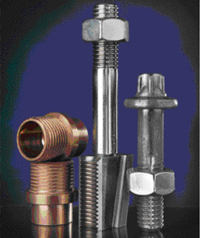Segmented Tooling Creates Formed Threads in Fasteners
July 1, 2009Comments
Metalformers have long strived to produce formed threads in a stamping press.
Historically, thread-forming failures mainly were attributed to tooling complexity, inability to accurately control the process, and an excessive number of variables in the thread requirements.
 |
To form an outside thread, Sieber Tool —a tooling and engineering supplier serving the cold-heading industry—developed a similar concept, except that the segments form the thread. The blank being formed has recesses formed in a previous station to allow for the flow of excess material. This avoids the possibility of material moving between the segments and prohibiting proper closure of the segments. The blank can be round with relief notches, providing for material flow. Sieber Tool has applied for a patent for the thread-forming concept.
During forming, the segments start to compress the material at the exterior sections of the formed lobes. The relief notches and blank configuration can take on many variations—the key is ensuring adequate room for material to flow into the relief area and not restrict the closure of the segments. Blank configuration should be developed using simulation software, to quicken development, minimize the gap and maximize manufacturability.
The relief notches result in minimal weakening of the component tensile strength—typically only 1 to 2 percent. And, the thread or feature can be conical or have any other custom shape. The shape also can vary along the length of the feature, and thread pitch can simulate a gear pitch or a coil spring (in pitch or transition in shape from rounded to sharp), and all simultaneously on the same feature.
The major difference from the formed thread to a rolled or cut thread is the configuration of the thread peaks. The peaks from a formed thread tend to be more rounded, without the sharp tips, and so a formed thread is less likely to cause injury from cuts and also is less likely to break from impact or shock. The rounded peak also provides improved coating adhesion.
Not only does thread forming in the press eliminate a costly secondary operation, it provides a completed component right off of the press. Applications ideally suited for the thread-forming process:
• Top-heavy parts;
• Parts with multiple features, flanges or knurls;
• Parts where threads must start immediately below the head or shoulder;
• Thin-walled and hollow parts;
• The starting point of the thread has a specific orientation;
• The thread can serve multiple functions by its shape and design—conical, polygon, sharp, modified pitch, etc.;
• The desired point profile does not allow for the rollover typical to thread rolling;
• The relief notches are used to clean out the mating thread;
• The relief notches are used to vent air, or drain oil or other liquids.
Sieber Tool Engineering L.P: 630/462-9370; www.siebertool.com
See also: SIEBER Tool Engineering L.P.
Technologies: Tooling







